By Carol Wyatt-Evens and Sarah Bostick
Gardening in Florida can be incredibly rewarding and incredibly frustrating, at the same time. If you are new to the region, you soon learn that gardening in the Sunshine State can quickly become a full-time job. While our subtropical climate is perfect for growing an abundance of different vegetables, fruits, and herbs, it also can present some overwhelming challenges.
We can help!
UF/IFAS Extension Sarasota County agents and staff have created an online edible gardening resource center. The website features short videos from our 25-episode “Edible Gardening Series” webinars, along with blog posts and resources list for episodes. Get help on an array of topics that befuddle many gardeners.
Each blog post in the Question of the Week blog series is associated with a specific EGS episode, but they are written for everyone to enjoy!
Question of the Week:
Are those spiders on my plants?
Spider mites are a big pest of garden and landscape plants. Although they are called ‘spider’ mites, they are mites and not spiders- although they are closely related. Both are in the class Arachnida which includes spiders, scorpions, ticks, and mites.
There are many different types of mites including microscopic mites that live in the soil, mites that live on animals, or even those that live in stored grains. There are also mites that feed on our edible garden, ornamental landscape, as well as many weed species- the spider mites. Spider mites are in the family Tetranychus and common in Florida landscapes. This family of mites has been found on over 300 species of plants and can cause extensive plant damage in a fairly short period of time – it is not a picky eater!
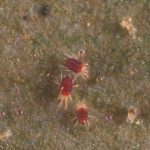
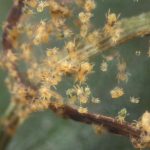

Spider Mites
Spider mites, as their name suggested, spin thin, silken webs that can cover individual plant leaves or the entire plant. The webbing is multi-purpose:
- It is used for protection for both the mites as well as the mite eggs.
- Mites use the webbing as a mite ‘highway system’ to allow them to easily move to new feeding areas within the plant.
- They use the webbing for a ‘take off’ point. When mite numbers get too large, they will move onto the webbing at the outer edge of the leaf and catch the breeze, taking them to an entirely new location to feed.

Adult spider mites are about 0.5mm long and have two dark spots on each side of their body. The mite body color can vary from pale green, greenish amber or yellowish-green. Spider mites are usually found in the lower canopy and move up through the plant as their population numbers increase.
Spider Mites Lifecycle
Spider mites populations are greater during hot and dry months, preferring low relative humidity between 30% to 60% and temperatures between 55°F and 98°F. In Central Florida and to the south, that’s April to June, although spider mites are present year-round. Mites live for 2 to 4 weeks and female spider mites can lay over 100 eggs during their life span.
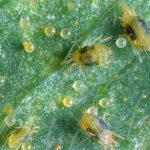
Once hatched from the egg, an immature spider mite can reach maturity in as little as 5 days in a perfect environment, but the average time is typically between 8 to 14 days. Adults mites will mate quickly after reaching maturity and females lay eggs soon after mating. This leads to many overlapping generations a season.
Spider Mite Plant Damage
Spider mites have sucking/piercing mouthparts and feed on the plants by sucking the plant sap from each cell. This shows up as white spots on the leaf called ‘stippling’. This leads to chlorotic yellowing and bronzing of the leaf as it becomes dry and shriveled.
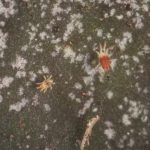

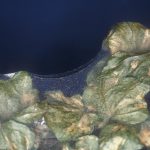
Spider mites will usually feed exclusively on one plant until it starts to decline, then they will move on to a new plant. When the infestation level is high, webbing will cover all -or part- of the leaf and the mites will start to migrate on to a new plant. Since the spider mites prefer a dry environment, rain events help to keep population levels in check.
Controlling Spider Mites
The key to controlling spider mites is not allowing them to establish and get too comfy. When it is dry and hot, spider mite infestations are more likely to occur. Monitoring early and often for the pests will help to catch the infestation before they can start to cause damage. Using a 10x hand lens will be extremely helpful in locating and identifying the pest mites.
Other measures to take to help control the spider mites:
- Conserve and support natural enemies – predatory mites, stink bugs, and thrips as well as ladybeetles and lacewing are all predators of spider mites. they need our help in allowing them to do their jobs. This means – minimizing or eliminating the use of pesticides or using only biorational pesticides when necessary.
- A strong blast of water – to infested plants will help knock off spider mites as well as mess with their feeding and reproduction.
- Reduce dust – through mulching and adding organic matter. Spider mites love a dusty environment, so keeping dust particles down will help control the mites.
- Prune off heavily infested leaves/stems – be sure to bag and toss the trimmings in the trash, not in the compost.
- Manage the weeds – many weeds are hosts to spider mites as well as other pest insects. Control the weeds and you will indirectly control the pests.
- Use biorational pesticides – only when necessary and be sure to read the label.
Factsheets and resources for gardening in Florida
- Two-spotted Spider Mite – Life Cycle
- Two-spotted Spider Mite, Tetranychus urticae Koch (Arachnida: Acari: Tetranychidae)
Photo credits: T. gloveri, T. evansi, T. urticae stippling damage – L. Buss, UF; T. urticae, T. urticae adults and eggs, webbing covering plant – J. Castner, UF; two-spotted spider mite webbing highway – D. Cappaert, Bugwood; stippling feeding on beans – W. Cranshaw, Colorado State Univ, Bugwood;
The Edible Gardening Series and blog series is a partnership between the following UF/IFAS agents and Sarasota County staff:
- Sarah Bostick, Sustainable Agriculture Agent
- Carol Wyatt-Evens, Chemicals in the Environment Agent
- Mindy Hanak, Community and School Gardens Program Coordinator
- Kevin O’Horan, Communications and Marketing Coordinator
 1
1
